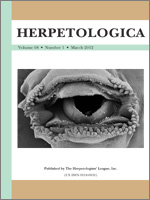We examined the morphology and somatic growth rate of Green Sea Turtles living in San Diego Bay, California; one of the northern-most foraging areas for the species in the eastern Pacific. A power plant had discharged heated effluent into the urbanized bay from 1960 to 2010. Straight carapace lengths of 101 Green Sea Turtles were recorded from 31 March 1990 to 15 April 2011 (45.4 to 110.4 cm). Green Sea Turtles in San Diego Bay were morphologically indistinguishable from those foraging in Baja California Sur, Mexico. The median growth rate was 1.03 cm/yr (−1.6 to 11.4 cm/yr) for all turtles and was 4.9 cm/yr for turtles ≤90 cm. These growth rates were one of the fastest for the species in temperate areas and comparable to those reported for tropical regions. The estimated growth parameter of the von Bertalanffy growth function (mean growth coefficient = 0.21, 95% posterior interval = 0.19–0.23) also was greater than for other populations of Green Sea Turtles. Based on behavioral observations and information from other diet studies, we think that the altered environment from the power plant effluent affected the growth of the Green Sea Turtles directly (longer active periods) and via shifts in the environment (changes in prey composition, abundance, and distribution). With the termination of the power plant operation at the end of 2010, the ecosystem is reverting to its natural state, which we expect will result in decreased growth rates of these turtles in the coming years.
How to translate text using browser tools
1 March 2012
Morphology and Growth Rates of the Green Sea Turtle (Chelonia mydas) in a Northern-most Temperate Foraging Ground
Tomoharu Eguchi,
Jeffrey A. Seminoff,
Robin A. LeRoux,
Dan Prosperi,
Donna L. Dutton,
Peter H. Dutton
ACCESS THE FULL ARTICLE

Herpetologica
Vol. 68 • No. 1
March 2012
Vol. 68 • No. 1
March 2012
anthropogenic effects
endangered species
growth model
Hierarchical analysis
Power plant
von Bertalanffy




